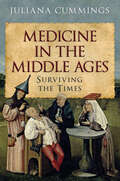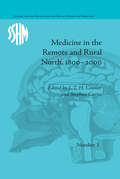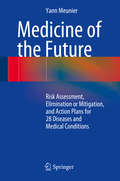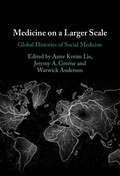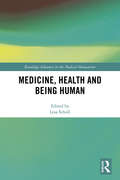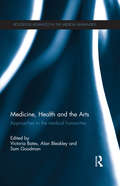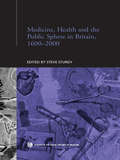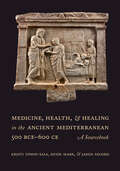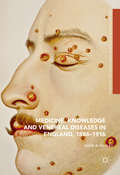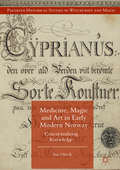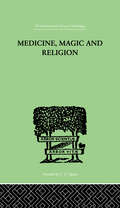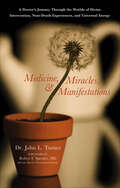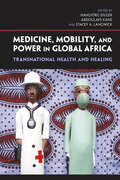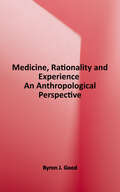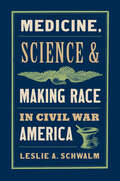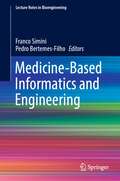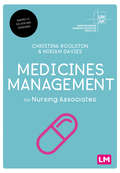- Table View
- List View
Medicine in the Middle Ages: Surviving the Times
by Juliana CummingsThe Middle Ages covers a span of roughly one thousand years, and through that time people were subject to an array of not only deadly diseases but deplorable living conditions. It was a time when cures for sickness were often worse than the illness itself mixed with a population of people who lacked any real understanding of sanitation and cleanliness. Dive in to the history of medieval medicine, and learn how the foundations of healing were built on the knowledge of ancient Greek and Roman philosophers. Understand how your social status would have affected medical care, and how the domination of the Catholic Church was the basis of an abundant amount of fear regarding life and death. We are given an intimate look into the devastating time of the Black Death, along with other horrific ailments that would have easily claimed a life in the Middle Ages. Delve inside the minds of the physicians and barbersurgeons for a better understanding of how they approached healing. As well as diving into the treacherous waters of medieval childbirth, Cummings looks into the birth of hospitals and the care for the insane. We are also taken directly to the battlefield and given the gruesome details of medieval warfare and its repercussions. Examine the horrors of the torture chamber and execution as a means of justice. Medicine in the Middle Ages is a fascinating walk through time to give us a better understanding of such a perilous part of history.
Medicine in the Remote and Rural North, 1800–2000 (Studies for the Society for the Social History of Medicine #3)
by J. T. H. Connor Stephan CurtisThis volume of thirteen essays focuses on the health and treatment of the peoples of northern Europe and North America over the course of the nineteenth and twentieth centuries.
Medicine of the Future
by Yann MeunierThis book outlines risk assessments for 28 diseases and medical conditions including the following aspects: genetics, biochemistry, serology, past medical history, family history, co-morbidities, age, gender, ethnicity, nutrition and lifestyle. Recommendations are made for how to avoid, eliminate or mitigate risks. Preventing measures concerning chemical compound intake, lifestyle and nutrition are proposed. The unique content and approach of the book to chronic disease management make it a state-of-the-art reference work, addressing a missing component of medical care and reflecting the cutting edge of preventive medicine.
Medicine on a Larger Scale: Global Histories of Social Medicine
by Warwick Anderson Jeremy A. Greene Lie Anne KveimIn a world of growing health inequity and ecological injustice, how do we revitalize medicine and public health to tackle new problems? This groundbreaking collection draws together case studies of social medicine in the Global South, radically shifting our understanding of social science in healthcare. Looking beyond a narrative originating in nineteenth-century Europe, a team of expert contributors explores a far broader set of roots and branches, with nodes in Sub-Saharan Africa, South America, Oceania, the Middle East, and Asia. This plural approach reframes and decolonizes the study of social medicine, highlighting connections to social justice and health equity, social science and state formation, bottom-up community initiatives, grassroots movements, and an array of revolutionary sensibilities. As a truly global history, this book offers a more usable past to imagine a new politics of social medicine for medical professionals and healthcare workers worldwide. This title is also available as open access on Cambridge Core.
Medicine over Mind: Mental Health Practice in the Biomedical Era (Critical Issues in Health and Medicine)
by Dena T. SmithWe live in an era in which medicalization—the process of conceptualizing and treating a wide range of human experiences as medical problems in need of medical treatment—of mental health troubles has been settled for several decades. Yet little is known about how this biomedical framework affects practitioners’ experiences. Using interviews with forty-three practitioners in the New York City area, this book offers insight into how the medical model maintains its dominant role in mental health treatment. Smith explores how practitioners grapple with available treatment models, and make sense of a field that has shifted rapidly in just a few decades. This is a book about practitioners working in a medicalized field; for some practitioners this is a straightforward and relatively tension-free existence while for others, who believe in and practice in-depth talk therapy, the biomedical perspective is much more challenging and causes personal and professional strains.
Medicine without Meds: Transforming Patient Care With Digital Therapies
by Dean Ho Yoann Sapanel Agata BlasiakMedicine, Government and Public Health in Philip II's Spain: Shared Interests, Competing Authorities (The\history Of Medicine In Context Ser.)
by Michele L. ClouseBridging the gap between histories of medicine and political/institutional histories of the early modern crown, this book explores the relationship between one of the most highly bureaucratic regimes in early modern Europe, Spain, and crown interest in and regulation of medical practices. Complementing recent histories that have emphasized the interdependent nature of governance between the crown and municipalities in sixteenth-century Spain, this study argues that medical policies were the result of negotiation and cooperation among the crown, the towns, and medical practitioners. During the reign of Philip II (1556-1598), the crown provided unique opportunities for advancements in the medical field among practitioners and support for the creation and dissemination of innovative medical techniques. In addition, crown support for and regulation of medicine served as an important bureaucratic tool in the crown's effort to expand and solidify its authority over the distinct kingdoms and territories under Castilian authority and the municipalities within the kingdom of Castile itself. The crown was not the only agent of change in the medical world, however. Medical policies and their successful implementation required consensus and cooperation among competing political authorities. Bringing to life a cast of characters from early modern Spain, from the female empiric who practiced bonesetting and surgery to the university-trained, Latin physician whose medical textbook standardized medical education in the universities, the book will broaden the scope of medical history to include not only the development of medical theory and innovative practice, but also address the complex tensions between various authorities which influenced the development and nature of medical practice and perceptions of 'public health' in early modern Europe. Juxtaposing the history of medicine with the history of early modern state-building brings a unique perspective to this challenging book that reassesses the relationship between the monarch and intellectual milieu of medicine in Spain. It further challenges the dominance of studies of medical regulation from France and England and illuminates a diverse and innovative world of Spanish medical practice that has been neglected in standard histories of early modern medicine.
Medicine, Health and Being Human (Routledge Advances in the Medical Humanities)
by Lesa SchollMedicine, Health and Being Human begins a conversation to explore how the medical has defined us: that is, the ways in which perspectives of medicine and health have affected cultural understandings of what it means to be human. With chapters that span from the early modern period through to the contemporary world, and are drawn from a range of disciplines, this volume holds that incremental historical and cultural influences have brought about an understanding of humanity in which the medical is ingrained, consciously or unconsciously, usually as a mode of legitimisation. Divided into three parts, the book follows a narrative path from the integrity of the human soul, through to the integrity of the material human body, then finally brought together through engaging with end-of-life responses. Part 1 examines the move from spirituality to psychiatry in terms of the way medical science has influenced cultural understandings of the mind. Part 2 interrogates the role that medicine has played in the nineteenth and twentieth centuries in constructing and deconstructing the self and other, including the fusion of visual objectivity and the scientific gaze in constructing perceptions of humanity. Part 3 looks at the limits of medicine when the integrity of one body breaks down. It contends with the ultimate question of the extent to which humanity is confined within the integrity of the human body, and how medicine and the humanities work together toward responding to the finality of death. This is a valuable contribution for all those interested in the medical humanities, history of medicine, history of ideas and the social approaches to health and illness.
Medicine, Health and the Arts: Approaches to the Medical Humanities (Routledge Advances in the Medical Humanities)
by Sam Goodman Alan Bleakley Victoria BatesIn recent decades, both medical humanities and medical history have emerged as rich and varied sub-disciplines. Medicine, Health and the Arts is a collection of specially commissioned essays designed to bring together different approaches to these complex fields. Written by a selection of established and emerging scholars, this volume embraces a breadth and range of methodological approaches to highlight not only developments in well-established areas of debate, but also newly emerging areas of investigation, new methodological approaches to the medical humanities and the value of the humanities in medical education. Divided into five sections, this text begins by offering an overview and analysis of the British and North American context. It then addresses in-depth the historical and contemporary relationship between visual art, literature and writing, performance and music. There are three chapters on each art form, which consider how history can illuminate current challenges and potential future directions. Each section contains an introductory overview, addressing broad themes and methodological concerns; a case study of the impact of medicine, health and well-being on an art form; and a case study of the impact of that art form on medicine, health and wellbeing. The underlining theme of the book is that the relationship between medicine, health and the arts can only be understood by examining the reciprocal relationship and processes of exchange between them. This volume promises to be a welcome and refreshing addition to the developing field of medical humanities. Both informative and thought provoking, it will be important reading for students, academics and practitioners in the medical humanities and arts in health, as well as health professionals, and all scholars and practitioners interested in the questions and debates surrounding medicine, health and the arts.
Medicine, Health and the Public Sphere in Britain, 1600-2000 (Routledge Studies in the Social History of Medicine #Vol. 16)
by Steve SturdyMedicine is concerned with the most intimate aspects of private life. Yet it is also a focus for diverse forms of public organization and action. In this volume, an international team of scholars use the techniques of medical history to analyse the changing boundaries and constitution of the public sphere from early modernity to the present day. In a series of detailed historical case studies, contributors examine the role of various public institutions - both formal and informal, voluntary and statutory - in organizing and coordinating collective action on medical matters. In so doing, they challenge the determinism and fatalism of Habermas's overarching and functionalist account of the rise and fall of the public sphere. Of essential interest to historians and sociologists of medicine, this book will also be of value to historians of modern Britain, historical sociologists, and those engaged in studying the work of Jürgen Habermas.
Medicine, Health, and Healing in the Ancient Mediterranean (500 BCE–600 CE): A Sourcebook
by Kristi Upson-SaiaThis sourcebook provides an expansive picture of medicine, health, and healing in ancient Greece and Rome. Covering a wide array of fascinating topics—such as ancient diagnostic practices using the pulse and urine, gynecological theories of women’s illness, treatments involving drugs and surgery, the training and work of physicians, the experiences of patients, and various sites where healing took place—this volume will engage readers interested in the rich history of health and healthcare. The volume brings together textual sources—many hard to access and some translated into English for the first time—as well as artistic, material, and scientific evidence, including: Medical treatises Case studies Artistic works Material artifacts Archaeological evidence Biomedical remains Funerary monuments Miracle narratives Spells and magical recipes With substantial explanation of these varied materials—through background chapters, introductions to the thematic chapters, a timeline, and a glossary—the volume is accessible to a broad audience. Readers will come away with a nuanced understanding of the illnesses people in ancient Greece and Rome experienced, the range of healers from whom they sought help, and the various practices they employed to be healthy.
Medicine, Knowledge and Venereal Diseases in England, 1886-1916 (Medicine And Biomedical Sciences In Modern History Ser.)
by Anne R. HanleyThis book reveals the ever-present challenges of patient care at the forefront of medical knowledge. Syphilis and gonorrhoea played upon the public imagination in Victorian and Edwardian England, inspiring fascination and fear. Seemingly inextricable from the other great 'social evil', prostitution, these diseases represented contamination, both physical and moral. They infiltrated respectable homes and brought terrible suffering and stigma to those afflicted. Medicine, Knowledge and Venereal Diseases takes us back to an age before penicillin and the NHS, when developments in pathology, symptomology and aetiology were transforming clinical practice. This is the first book to examine systematically how doctors, nurses and midwives grappled with new ideas and laboratory-based technologies in their fight against venereal diseases in voluntary hospitals, general practice and Poor Law institutions. It opens up new perspectives on what made competent and safe medical professionals; how these standards changed over time; and how changing attitudes and expectations affected the medical authority and autonomy of different professional groups.
Medicine, Magic and Art in Early Modern Norway: Conceptualizing Knowledge (Palgrave Historical Studies In Witchcraft And Magic )
by Ane OhrvikTraces conceptual ideas of knowledge in Norway from the seventeenth to nineteenth centuries.<P> Assesses how magic and medicine were viewed as practical and sacred in early modern Europe.<P> Utilises a wide range of early modern manuscripts from 1650 -1850, known as Black Books.<P> This book addresses magical ideas and practices in early modern Norway. It examines a large corpus of Norwegian manuscripts from 1650-1850 commonly called Black Books which contained a mixture of recipes on medicine, magic, and art. Ane Ohrvik assesses the Black Books from the vantage point of those who wrote the manuscripts and thus offers an original study of how early modern magical practitioners presented their ideas and saw their practices. The book show how the writers viewed magic and medicine both as practical and sacred art and as knowledge worth protecting through encoding the text. The study of the Black Books illuminates how ordinary people in Norway conceptualized magic as valuable and useful knowledge worth of collecting and saving despite the ongoing witchcraft prosecutions targeting the very same ideas and practices as the books promoted. Medicine, Magic and Art in Early Modern Norway is essential for those looking to advance their studies in magical beliefs and practices in early modern Europe as well as those interested in witchcraft studies, book history, and the history of knowledge.
Medicine, Magic and Religion: The FitzPatrick Lectures delivered before The Royal College of Physicians in London in 1915-1916 (International Library Of Psychology Ser. #Vol. 35)
by W. H. RiversFirst Published in 1999. Routledge is an imprint of Taylor & Francis, an informa company.
Medicine, Malpractice and Misapprehensions (Biomedical Law and Ethics Library)
by V.H. HarpwoodAnalyzing the level of claims for clinical negligence in the light of the most recent trends and discovering whether there is indeed a litigation crisis in healthcare, this book is a topical and compelling exploration of healthcare and doctor-patient relationships. The author: identifies and analyzes the growing pressures on doctors in modern society, placing their role in context explores some of the myths surrounding media claims about malpractice considers the practice of ‘defensive medicine’ and the difference between defensive practices and sensible risk management examines external pressures, such as political interference with clinical practice in the form of target-setting and what might be described as a culture of creeping privatization of healthcare. Covering the topics of medicine and the media and the causes of occupational stress among doctors, this volume is a must read for all students of medical law and medical ethics.
Medicine, Miracles, & Manifestations: A Doctor's Journey Through the Worlds of Divine Intervention, Near-Death Experiences, and Universal Energy
by John L. Turner“A fascinating real-life voyage through medicine and beyond. . . . Intensely human and readable. Full of hope and wonder. A truly heartwarming page turner.” —Robert Bruce, author of Astral Dynamics and Energy WorkMedicine, Miracles, and Manifestations is a nonfiction narrative about the surgical career and spiritual quest of neurosurgeon Dr. John L. Turner and his journey into the field of Integral Medicine. During his career as a board-certified surgeon, Dr. Turner’s curiosity drove him to explore nontraditional healing techniques that broadened the scope of recovery for his patients, including energy healing, chanting and meditation (approaches historically found in religious practices), soul travel, and astral projection. In this fascinating book, you will discover:• How metaphysical events such as remote viewing, telepathy, consciousness, and life after death are all verifiable manifestations of the way the human brain interfaces with the universal consciousness.• That consciousness persists after the death of the physical body• That our life is carefully planned before birth but there is an element of free will.• That we can interface with a spiritual world and a collective human unconscious.“I admire Dr. Turner for having the courage to share his life and truths with us. I truly recommend this book to every health professional and those willing to open their minds and accept the true nature of life. You will be touched by the stories he shares; his book can help you open your mind and become aware of new and exciting aspects of true healing and curing.” —Dr. Bernie Siegel, author of Love, Medicine & Miracles and Prescriptions For Living
Medicine, Mobility, and Power in Global Africa: Transnational Health and Healing
by Hansjörg Dilger Abdoulaye Kane Stacey A. LangwickRecent political, social, and economic changes in Africa have provoked radical shifts in the landscape of health and healthcare. Medicine, Mobility, and Power in Global Africa captures the multiple dynamics of a globalized world and its impact on medicine, health, and the delivery of healthcare in Africa—and beyond. Essays by an international group of contributors take on intractable problems such as HIV/AIDS, malaria, and insufficient access to healthcare, drugs, resources, hospitals, and technologies. The movements of people and resources described here expose the growing challenges of poverty and public health, but they also show how new opportunities have been created for transforming healthcare and promoting care and healing.
Medicine, Rationality and Experience: An Anthropological Perspective (Lewis Henry Morgan Lectures)
by Byron J. GoodBiomedicine is often thought to provide a scientific account of the human body and of illness. In this view, non-Western and folk medical systems are regarded as systems of 'belief' and subtly discounted. This is an impoverished perspective for understanding illness and healing across cultures, one that neglects many facets of Western medical practice and obscures its kinship with healing in other traditions. Drawing on his research in several American and Middle Eastern medical settings, in this 1993 book Professor Good develops a critical, anthropological account of medical knowledge and practice. He shows how physicians and healers enter and inhabit distinctive worlds of meaning and experience. He explores how stories or illness narratives are joined with bodily experience in shaping and responding to human suffering and argues that moral and aesthetic considerations are present in routine medical practice as in other forms of healing.
Medicine, Risk, Discourse and Power (Routledge Advances in Sociology)
by John Martyn ChamberlainThis book critically explores from a comparative international perspective the role medicine plays in constructing and managing natural and social risks, including those belonging to modern medical technology and expertise. Drawing together chapters written by professional practitioners and social scientists from the UK, South America, Australia and Europe, the book offers readers an insightful and thought-provoking analysis of how modern medicine has transformed our understanding of both ourselves and the world around us, but in so doing has arguably failed to fully recognize and account for, its unintended and negative effects. This is an essential read for social scientists, practitioners and policymakers who want to better understand how they can develop new ways of thinking about how modern medicine can promote social goods and enhance public health.
Medicine, Science, and Making Race in Civil War America
by Leslie A. SchwalmThis social and cultural history of Civil War medicine and science sheds important light on the question of why and how anti-Black racism survived the destruction of slavery. During the war, white Northerners promoted ideas about Black inferiority under the guise of medical and scientific authority. In particular, the Sanitary Commission and Army medical personnel conducted wartime research aimed at proving Black medical and biological inferiority. They not only subjected Black soldiers and refugees from slavery to substandard health care but also scrutinized them as objects of study. This mistreatment of Black soldiers and civilians extended after life to include dissection, dismemberment, and disposal of the Black war dead in unmarked or mass graves and medical waste pits. Simultaneously, white medical and scientific investigators enhanced their professional standing by establishing their authority on the science of racial difference and hierarchy. Drawing on archives of the U.S. Sanitary Commission, recollections of Civil War soldiers and medical workers, and testimonies from Black Americans, Leslie A. Schwalm exposes the racist ideas and practices that shaped wartime medicine and science. Painstakingly researched and accessibly written, this book helps readers understand the persistence of anti-Black racism and health disparities during and after the war.
Medicine-Based Informatics and Engineering (Lecture Notes in Bioengineering)
by Franco Simini Pedro Bertemes-FilhoThis book originates from the idea to adapt biomedical engineering and medical informatics to current clinical needs and proposes a paradigm shift in medical engineering, where the limitations of technology should no longer be the starting point of design, but rather the development of biomedical devices, software, and systems should stem from clinical needs and wishes. Gathering chapters written by authoritative researchers, working the interface between medicine and engineering, this book presents successful attempts of conceiving technology based on clinical practice. It reports on new strategies for medical diagnosis, rehabilitation, and eHealth, focusing on solutions to foster better quality of life through technology, with an emphasis on patients’ and clinical needs, and vulnerable populations. All in all, the book offers a reference guide and a source of inspiration for biomedical engineers, clinical scientists, physicians, and computer scientists. Yet, it also includes practical information for personnel using biomedical equipment, as well as timely insights that are expected to help health agencies and software firms in their decision-making processes.
Medicine: The Definitive Illustrated History (DK Definitive Visual Histories)
by DKSee the greatest medical breakthroughs come to life through superb illustrations!From ancient herbal medicine to traditional Chinese medicine, take a visual tour throughout the history of medicine with this comprehensive medical reference book.Discover medicine through time! Here&’s what you&’ll find in this illustrated history book about medicine: • Offers a broad and accessible visual history of medicine — from the first herbal remedies to efforts surrounding the COVID-19 pandemic • Intriguing narratives are illustrated with photographs, paintings and artifacts • Offers a vivid, compelling and informative read written in an engaging and colourful style • Excerpts from documents, diaries and notebooks offer fascinating eyewitness accounts This medicine history book charts fascinating developments in diagnosis, surgery, healing and drugs through the ages. Feature spreads explore key medical concepts in detail and enhance the reader&’s understanding of human anatomy, surgical instruments and medical developments. Clear diagrams explain major diseases like cancer, and trace the progression of medical treatment through time, from ancient healing arts to scurvy and smallpox to modern psychiatry. Double-page features tell the story of the men and women involved in the extraordinary evolutions of this scientific field — from Hippocrates to Florence Nightingale.It's the perfect book for medical professionals, students of medicine or anyone with a keen interest in medicine, science or social history.
Medicinema: Doctors in Films (Radcliffe Ser.)
by Brian Glasser Sally IrvineCinema and medicine have been inextricably linked since the earliest days of film, with doctors appearing in fictional films before criminals, the clergy or even cowboys. But why have healthcare professionals - often played by major stars - featured so prominently in film history, and what does this have to tell us now? Responding to Alexander, Lenahan and Pavlov's Cinemeducation (Radcliffe, 2005) which focused on the uses of cinema in medical teaching, this book instead examines what film has to say about medicine, its practitioners, and their cultural meaning. Drawing on a miscellany of films from the dawn of cinema to the 2000s, from horror and westerns to war films and art cinema, and informed by a film and cultural studies-based approach, this will be a valuable text for students of medical or film history, researchers in the medical humanities, and medical practitioners with an interest in the portrayal and cultural representation of their profession.
Medicines Management for Nurses at a Glance
by Simon Young Ben PitcherAn easy-to-read and supportive guide to the key pharmacological knowledge nurses need to know. Written specifically for nurses, it covers the fundamentals of pharmacology as they apply to nursing practice. Breaks down complex concepts in an accessible way, providing helpful overviews of all key pharmacological topics. Includes practical issues relating to practice, and is written to support the Essential Skills Cluster of the NMC, and the content of the BNF. Includes content relevant to each of the four fields of nursing, and covers drugs for specific groups such as children, pregnant and breastfeeding women, and the elderly.
Medicines Management for Nursing Associates (Understanding Nursing Associate Practice)
by Christina Roulston Miriam DaviesThe first medicines management textbook for trainee nursing associates! Effectively managing and administering medicines is a core responsibility for all Nursing Associates. To help you master these skills, this book covers everything you will need to know in medicines management, from understanding the fundamental legal and professional requirements, to developing essential drug calculations skills. By breaking down this often-overwhelming subject into manageable chunks, the book guides you through it all, step-by-step, with the help of insightful case studies and activities. Key features: Fully mapped to the new NMC standards of proficiency for nursing associates (2018) Activities and other learning features help you get to grips with the key skills Wide-ranging case studies covering all fields and environments show how this knowledge applies to your practice. ABOUT THE SERIES: The Understanding Nursing Associate Practice series (UNAP) is a new collection of books uniquely designed to support trainee Nursing Associates throughout their training and into a professional career.
